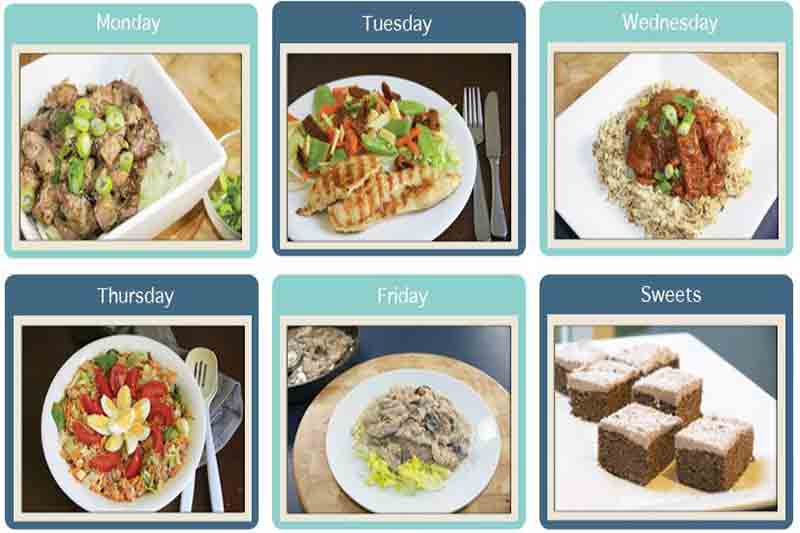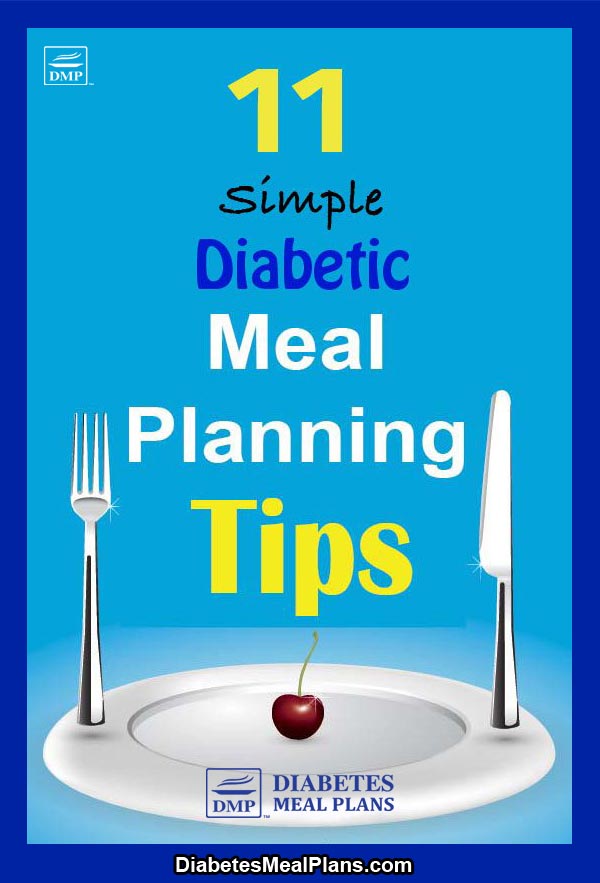Table of Contents[Hide][Show]
I love cooking. But I know many people either don’t know how to cook or don’t like to cook all that much.
I do believe it’s something you can learn to enjoy. But, even though I do like cooking, I don’t want to be chained to the sink. So much of the time the recipes I create (and the ones we share here at DMP) are super easy.
I’m always looking for time savers and short cuts to get dinner on the table, faster!
By following some simple meal planning tips, you’ll not only eat well, and get dinner on the table faster. But you’ll keep your type 2 diabetes in check, which is exactly what you want, right?

Why is meal planning so great?
If you’ve never been a meal planner, you’re really missing out because it saves money, saves time, saves stress, and stops you wandering off eating things you probably shouldn’t eat – aka high carb foods!
Saves you money
Meal planning saves you money because you buy only what you need to make the meals, so there is much less food wastage, meaning you’re not throwing money in the trash.
If you do have leftover food items or things in the pantry you want to use up, then you can factor those into your meal plan and it saves you money.
Also, if you stick to your shopping list, you stop making impulsive buys when you’re at the store. Supermarkets often try to get us to make impulsive buys based on ‘specials’ but the reality is, often we really don’t need or want those items. So keep your radars on and stick to your shopping list because it really does save you money in the long run.
Saves you time and stress
Take a second to reflect on how much time you think about what you’re going to eat for dinner, or what you’re going to take to work for lunch. If you don’t make a plan, you have to think about it day in and day out and that takes time and energy.
It can also lead to more stress if you’re left having to make decisions right at the last minute. Or you might go and grab fast food take away because you’re feeling stressed. Only then you start beating yourself up because you didn’t eat as healthy as you’d like, your blood sugar levels increase, and so you become even more stressed.
I think you get the picture and you’ve probably experienced these things yourself from time to time. But if you get into the habit of meal planning, you don’t have to feel this way.
Use the following tips to start putting meal planning into your weekly routine.
10 Simple Type 2 Diabetes Meal Planning Tips
1. Make the time to plan
Sounds like an obvious thing to mention, but unless you take an hour or so to plan each week, then the plan is never going to happen. Although planning does take time, in the long run it does save time, energy, money and stress – as previously mentioned.
I don’t like shopping much, so I often do a big biweekly midweek shop, which means I have to plan out my meals way ahead of time so I can get enough produce to last. I often spend time over a cup of tea and work out what the two weeks might look like. Since I’m always coming up with new recipes and ideas for DMP, I also include those in my plan.
Your planning might not go to plan the first few times round, but you do get better at it over time. So, just start somewhere, even if it’s just planning dinners at first. But the key is to schedule a time to do it. And make sure you do in fact, do it!
2. Think about your weekly schedule
While creating your meal plan, keep your diary or calendar handy so you can ensure you plan the right meals for the right times. For instance, if I’m going to be home late on Tuesday evening, I certainly don’t want to be short on time to cook and have to prepare tomorrows meals as well.
So on days like this I will often have stuff in the freezer that I get out in the morning and throw together with a salad. Or I’ll put on a slow cooker meal and leave it cooking on low all day – that way dinner is cooked when I get home.
By having your weekly schedule handy while meal planning, you can also plan the times during the week when you might spend a bit more time in the kitchen doing prep or cooking bigger batches you can eat over a few days.
Which brings me to the next tip…
3. Batch cook
When my kids were younger, BIG batch cooking was my savior – it saves loads of time, there’s less clean up, and I say, if you’re going to eat once, why not eat twice. Or better yet, 3 or 4 times!
I usually make extra cooking time on Sundays and prepare extra things for freezing and for those days when time is short.
I also often do batch preparation – chopping a whole load of different veggies and putting them in containers in the fridge, so I don’t have to do it every day.
Making big batches really is ideal because it doesn’t take too much extra effort.
4. Use theme nights
If you’re not overly creative, try sticking to a regular theme each night of the week.
For instance:
Monday – Veggie and meat/ poultry stir fry
Tuesday – Tacos (yes, these can be done low carb!)
Wednesday – low carb junk food revival (pizza or burgers – yes, these can be done low carb!)
Thursday – low carb pasta/ noodle dish (again, there are lots of low carb options)
Friday – slow cooked meal
You could use that same theme template over and over for weeks on end and have different low carb meals to fill the gaps each and every week.
5. Write it down
You might be able to keep the plan in your head but it’s probably not efficient to do it that way, so be sure you write your meal plan down.
Or even better, use a smart meal planner such as the one we have inside the DMP Members site.
Our smart meal planner allows you to use ready-made meal plans or make your own. And it calculates all your nutrition facts for you.
Check out what it does:
When planning meals, I generally find planning for 5 days is usually sufficient because you might have leftovers or substitute for something along the way, and those slight deviations will usually fill up the extra 2 days.
As you are making your plan think about the ingredients involved in each meal and how they might cross over from one day to another or one meal to another. This will help you keep your produce and purchases within your budget and there won’t be any food that goes to waste either. I really don’t like seeing food go to waste!
6. Throw new recipes in there
To ensure you don’t get bored, keep your meal plans interesting by throwing at least one new recipe or flavor into the mix each week.
There’s nothing worse than feeling like you want to cheat because you’re bored, so it’s always good to keep things interesting!
7. Inspire with variety
Try to include a variety of different protein sources – different red meats, some chicken and a bit of fish or seafood.
Include a good variety of non starchy vegetables.
And aim for the inclusion of a variety of healthy fat sources as well – avocado, nuts, seeds, olive oil, olives.
When you get variety, your diet naturally feels more balanced overall and that’s always more satisfying.

8. Make your short list of go-to recipes
Get a short list of super easy meals and recipes that you enjoy eating and post them on your fridge.
Then when you go to make up your meal plans every week, you can refer to your list and choose a few things you haven’t had for a while. You can also keep these in a note book and keep adding new recipes and meals to the list as you discover them.
Or, if you become one of our VIP members, you can save all your recipe favorites in your “My Favs” list where you can access them anytime.
9. Write a grocery list (and stick to it)
Never go shopping without a grocery list!
You’ll end up getting things you didn’t want and forget things that you really need. Plus, you can waste money on impulse purchases.
Write a basic grocery list based on your meal plans that you plan for the week. Or if you’re one of our members, you can create your “smart” shopping list and access it on your smartphone while shopping.
When you shop, stick to your list!
Sometimes certain ingredients may not be available so you can substitute with other vegetables or meats if need be. Most recipes will lend themselves well to alterations and deviations.
Most importantly, don’t make any impulsive buys.
10. Cook and enjoy
Cook up your meals and put love into that food because it’s going into your body to nourish you, to build your body, mind and soul.
Really try to enjoy and value the process of creating nourishing food to eat.
We are very lucky to be able to have access to a variety of healthy wonderful foods, when so many people in the world go hungry.
You are also very lucky that eating and cooking your own food helps you control all of the ingredients and nutrients that enter your body so you can focus on improving your condition.

If you can eat your way into something, you CAN eat your way out of it, too!
Be grateful and put love into the food you make.
11. Use our smart meal planner
If you’re too lazy to make a meal plan each week, still don’t know how, or just want an easier way to do it, try our smart meal planner.
You can select one of our ready-made meal plans or choose from more than 500 delicious low carb recipes (5 ingredient super easy meals, breads, pastries, burgers, slow cooker meals, breakfasts, lunches, dinners) – just add them to your smart meal planner and it will automatically calculate your daily nutrition facts – calories, carbs, proteins and fats.
Watch this video to see the smart meal planning features.


Leave a Reply